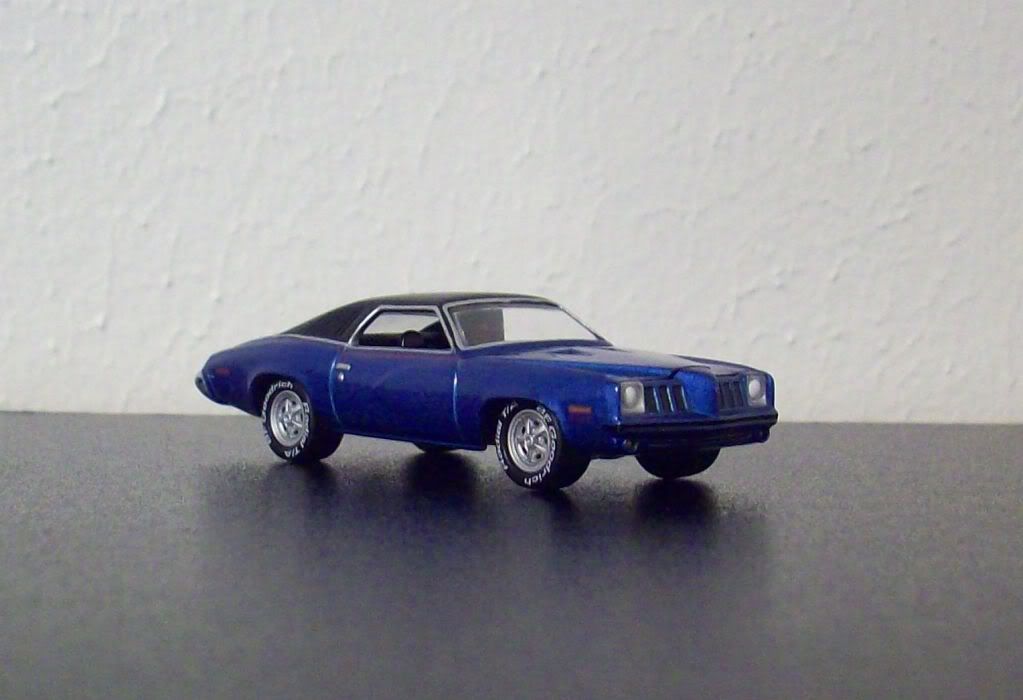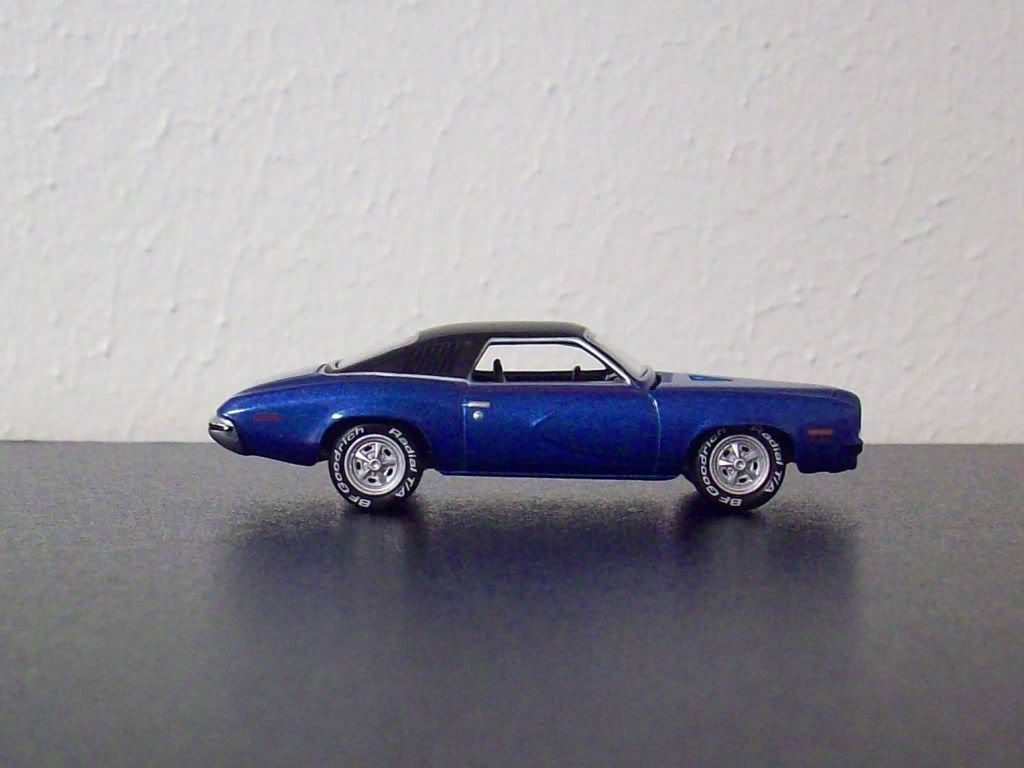
A blog focusing on 1/64 diecast from such popular brands as Hot Wheels, Matchbox, Johnny Lightning, M2 Machines, GreenLight, Tomica, Yat Ming, Majorette, MotorMax, Siku, Corgi, Guisval, Playart, Ertl, Zylmex, Racing Champions, & many more. Swifty's Garage features a daily Car Of The Day and news updates from your favorite brands!
Friday, February 4, 2011
Car Of The Day: February 4, 2011
Today's car of the day is from Firehawk73's collection and is Johnny Lightning's 1973 Pontiac Grand Am.
The Pontiac Grand Am is a mid-size car and later a compact car that was produced by the Pontiac division of General Motors. The Grand Am had two separate 3-year runs in the '70s: from 1973 to 1975 and again from 1978 to 1980. It was based on the GM A platform. Production of the Grand Am was canceled in 1980 when it was replaced by the Pontiac 6000. The Grand Am was reintroduced in 1985 when it replaced the Pontiac Phoenix. It was Pontiac's best selling car and later replaced by the Pontiac G6, so named as it was intended to be the 6th generation of the Grand Am. Grand Ams were built between 1973 and 1985 in Pontiac, Michigan at Pontiac's main assembly plant and in Atlanta, Georgia at GMAD Lakewood. All Grand Ams between 1985 and 2005 were built in Lansing, Michigan at the Lansing Car Assembly.
For more information and pictures of the real car: Pontiac Grand Am
The original Grand Am was introduced in the fall of 1972 as a 1973 model. It was based on the GM A platform (A-body) along with other cars such as the Pontiac LeMans, Pontiac GTO, Chevrolet Chevelle, Buick Century, and the Oldsmobile Cutlass Supreme. The GM A-body platform had major design revisions in 1973 that included the elimination of pillarless hardtops due to proposed federal rollover standards, but with frameless windows similar to that of a hardtop. No convertibles were produced due to those same federal rollover standards (that never were enacted). In addition to federal emissions regulations that reduced performance, new federal standards required a 5 mph (8.0 km/h) impact-resistant front bumper and a 2.5 mph (4.0 km/h) impact-resistant rear bumper, which increased to 5 mph (8.0 km/h) for 1974.
The Grand Am, coined by Pontiac with a name derived from two other cars in its lineup ("Grand" signifying "Grand Prix luxury" and "Am" for "Trans Am performance") was designed as America's answer to European luxury/sport sedans and available as a 4-door Colonnade sedan or a 2-door Colonnade coupe. 43,136 Grand Ams were built during the first year of production (both two door and four door models).
The Grand Am could be had with a standard 400/2bbl engine (6.5 Litre, 170 horsepower), an optional 400/4bbl engine (230 horsepower), or an optional 455/4bbl engine (7.4 Litre, 250 horsepower). Single or dual exhaust systems were also available. Originally planned but never materialized was the availability of 310 horsepower (230 kW) Super Duty 455/4bbl that was originally set to be available on several 1973 Pontiac models including the Grand Am, Grand Prix and GTO along with the Firebird Trans Am and Formula. However, production of the 455 SD was delayed from its planned debut at the start of the model year due to emissions considerations. Production of the 455 SD was delayed until the spring of 1973 and then it was made available only on the two Firebird models. One early '73 Grand Am prototype was reportedly assembled with the 455 SD engine.
The 400/2bbl, 400/4bbl, and 455/4bbl engines were available with a Turbo-hydramatic 400 automatic as standard equipment. A 4-speed manual transmission was available with the 400/4bbl engine in 1973 and 1974. It is unknown how many of the 1973 model year Grand Ams had the four-speed manual transmission, but it is estimated to be in the 600-900 range for 1973 and perhaps half that in 1974. The four speed manual transmission was available only with the 400/4bbl engine. All 400/2bbl and 455/4bbl equipped cars were automatics.
The 1973 Pontiac Grand Am style had a unique flexible urethane front fascia center nose (known as the 'Endura' nose) that was squeezable and could return back to its original shape following a minor collision along with the new energy-absorbing bumpers, a total of 6 grille openings with vertical bars, round front turn signals with a cross-hair design, horizontal rear tail lights, and chrome rear bumper. Additionally, Grand Ams featured a Radial Tuned Suspension (RTS) as standard equipment which included the radial-ply tires, Pliacell shock absorbers and front and rear sway bars for improved ride and handling. This basic suspension tuning also came standard with the Grand Prix SJ option in 1973 and optional on two other Pontiac models that year including the full-sized Bonneville and the sporty Firebird. The Grand Am was one of only three GM cars to come standard with radial tires and appropriate suspension tuning in 1973 with the others being the Oldsmobile Cutlass Salon and Chevrolet Monte Carlo S. For a 4200 pound car, it handled quite well, being both predictable and 'toss-able'.
Inside, the Grand Am came standard with Strato bucket seats upholstered in Naugahyde vinyl or corduroy cloth featuring manual recliners and adjustable lumbar supports - both features common on European-style sports/luxury sedans but unusual for American cars of that time. Also included were an instrument panel from the Pontiac Grand Prix featuring a Rally Gauge Cluster with full Fuel, Oil, Water and Volts instrumentation (tachometer or Fuel Economy gauge optional - on cars so equipped, the clock was moved to a space on the lower instrument panel under the radio), three-spoke padded steering wheel with brushed-stainless spokes, and Genuine Crossfire African Mahogany trim on the dash facing, radio and clock surrounds, as well as the center console between the front seats. Grand Ams also were among the first U.S.-built cars to come with a turn-signal mounted headlight dimmer switch that had been common on imported cars for decades. Upscale options included air conditioning, tinted glass, power windows-locks-seat, rear defogger, various sound systems and tilt-steering-wheel...
Pontiac also produced a single 1973 Grand Am station wagon as a feasibility study. This was a LeMans wagon converted to a Grand Am. A functional ram-air induction system was developed for the Pontiac A-bodies utilizing twin NACA openings in the hood, but the option was dropped due to inability to pass federally mandated drive-by noise standards. A few functional Ram Air systems were sold over the counter, but are extremely rare. The twin-scoop NACA hood was an option for any Pontiac A-body for all three years, but was non-functional.
Subscribe to:
Post Comments (Atom)





No comments:
Post a Comment